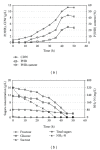Factors affecting poly(3-hydroxybutyrate) production from oil palm frond juice by Cupriavidus necator (CCUG52238(T))
- PMID: 23133311
- PMCID: PMC3477595
- DOI: 10.1155/2012/125865
Factors affecting poly(3-hydroxybutyrate) production from oil palm frond juice by Cupriavidus necator (CCUG52238(T))
Abstract
Factors influencing poly(3-hydroxybutyrate) P(3HB) production by Cupriavidus necator CCUG52238(T) utilizing oil palm frond (OPF) juice were clarified in this study. Effects of initial medium pH, agitation speed, and ammonium sulfate (NH(4))(2)SO(4) concentration on the production of P(3HB) were investigated in shake flasks experiments using OPF juice as the sole carbon source. The highest P(3HB) content was recorded at pH 7.0, agitation speed of 220 rpm, and (NH(4))(2)SO(4) concentration at 0.5 g/L. By culturing the wild-type strain of C. necator under the aforementioned conditions, the cell dry weight (CDW) and P(3HB) content obtained were 9.31 ± 0.13 g/L and 45 ± 1.5 wt.%, respectively. This accounted for 40% increment of P(3HB) content compared to the nonoptimized condition. In the meanwhile, the effect of dissolved oxygen tension (DOT) on P(3HB) production was investigated in a 2-L bioreactor. Highest CDW (11.37 g/L) and P(3HB) content (44 wt.%) were achieved when DOT level was set at 30%. P(3HB) produced from OPF juice had a tensile strength of 40 MPa and elongation at break of 8% demonstrated that P(3HB) produced from renewable and cheap carbon source is comparable to those produced from commercial substrate.
Figures
Similar articles
-
A study on the effects of increment and decrement repeated fed-batch feeding of glucose on the production of poly(3-hydroxybutyrate) [P(3HB)] by a newly engineered Cupriavidus necator NSDG-GG mutant in batch fill-and-draw fermentation.J Biotechnol. 2020 Jan 10;307:77-86. doi: 10.1016/j.jbiotec.2019.10.013. Epub 2019 Oct 25. J Biotechnol. 2020. PMID: 31669355
-
Recombinant Ralstonia eutropha engineered to utilize xylose and its use for the production of poly(3-hydroxybutyrate) from sunflower stalk hydrolysate solution.Microb Cell Fact. 2016 Jun 3;15:95. doi: 10.1186/s12934-016-0495-6. Microb Cell Fact. 2016. PMID: 27260327 Free PMC article.
-
Production of poly(3-hydroxybutyrate) and its copolymer poly(3-hydroxybutyrate-co-3-hydroxyvalerate) by Erwinia sp. USMI-20.Int J Biol Macromol. 1999 Jun-Jul;25(1-3):95-104. doi: 10.1016/s0141-8130(99)00020-3. Int J Biol Macromol. 1999. PMID: 10416655
-
Microbial production of poly-D-3-hydroxybutyrate from CO2.Appl Microbiol Biotechnol. 2001 Oct;57(1-2):6-12. doi: 10.1007/s002530100775. Appl Microbiol Biotechnol. 2001. PMID: 11693935 Review.
-
Recent advances in polyhydroxyalkanoate production by bacterial fermentation: mini-review.Int J Biol Macromol. 1999 Jun-Jul;25(1-3):31-6. doi: 10.1016/s0141-8130(99)00012-4. Int J Biol Macromol. 1999. PMID: 10416647 Review.
Cited by
-
Effect of glucose and olive oil as potential carbon sources on production of PHAs copolymer and tercopolymer by Bacillus cereus FA11.3 Biotech. 2017 May;7(1):87. doi: 10.1007/s13205-017-0712-y. Epub 2017 May 13. 3 Biotech. 2017. PMID: 28501987 Free PMC article.
-
Characterization of newly isolated thermotolerant bacterium Cupriavidus sp. CB15 from composting and its ability to produce polyhydroxyalkanoate from glycerol.Microb Cell Fact. 2023 Apr 12;22(1):68. doi: 10.1186/s12934-023-02059-5. Microb Cell Fact. 2023. PMID: 37046250 Free PMC article.
-
Potential use of Bacillus paramycoides for the production of the biopolymer polyhydroxybutyrate from leftover carob fruit agro-waste.AIMS Microbiol. 2022 Aug 8;8(3):318-337. doi: 10.3934/microbiol.2022023. eCollection 2022. AIMS Microbiol. 2022. PMID: 36317006 Free PMC article.
References
-
- Lee SY. Review bacterial polyhydroxyalkanoates. Biotechnology and Bioengineering. 1996;49:1–14. - PubMed
-
- Beom Soo Kim. Production of poly(3-hydroxybutyric acid) by fed-batch culture of Alcaligenes eutrophus with glucose concentration control. Biotechnology and Bioengineering. 1994;43(9):892–898. - PubMed
-
- Kim BS, Chang HN. Production of poly(3-hydroxybutyrate) from starch by Azotobacter chroococcum. Biotechnology Letters. 1998;20(2):109–112.
-
- Sei Kwang Hahn. Communication to the editor optimization of microbial poly(3- hydroxybutyrate) recovery using dispersions of sodium hypochlorite solution and chloroform. Biotechnology and Bioengineering. 1994;44(2):256–261. - PubMed
-
- Page WJ. Production of poly-β-hydroxybutyrate by Azotobacter vinelandii strain UWD during growth on molasses and other complex carbon sources. Applied Microbiology and Biotechnology. 1989;31(4):329–333.
Publication types
MeSH terms
Substances
LinkOut - more resources
Full Text Sources
Molecular Biology Databases


